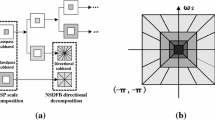Abstract
Face recognition, one of the biological recognitions, has received extensive concern due to its secrecy and friendly cooperation. Gabor wavelet is an important tool in face feature description. In order to reduce the loss of useful information during down sampling, this work puts forward a Gabor feature representation method based on block statistics, which enhances the efficiency of Gabor feature representation. This study was designed to explore face recognition algorithms on the basis of highly recognizable and real-time collaborative representation. Experimental results indicated that, the face recognition based on block Gabor feature collaborative representation not only guaranteed the calculation speed, but also took full advantage of the robustness of Gabor feature. Besides, the block Gabor feature containing more details further improved the recognition rate.
Similar content being viewed by others
References
Park, H., Ree, J.J., and Kim, K., Identification of promising patents for technology transfers using TRIZ evolution trends, J. Expert Syst. Appl., 2013, vol. 40, no. 2, pp. 736–743.
Unruh, A., Bailey, J., and Ramamohanarao, K., Building more robust multi-agent systems using a log-based approach, J. Web Intell. Agent Syst., 2009, vol. 7, no. 1, pp. 65–87.
Lim, M.H., Goi, B.M., and Lee, S.G., An analysis of group key agreement schemes based on the Bellare-Rogaway model in multi-party setting, KSII Trans. Internet Inf. Syst., 2011, vol. 5, no. 4, pp. 822–839.
Abaza, A.A., Day, J.B., Reynolds, J.S., et al., Classification of voluntary cough sound and airflow patterns for detecting abnormal pulmonary function, J. Cough, 2009, vol. 5, no. 1, pp. 1–12.
Liao, P. and Shen, L., Unified probabilistic models for face recognition from a single example image per person, J. Comput. Sci. Technol., 2004, vol. 19, no. 3, pp. 383–392.
Heisele, B., Ho, P., and Poggio, T., Face recognition with support vector machine: Global versus componentbased approach, IEEE International Conference on Computer Vision, Vancouver, BC, 2001, pp. 688–694.
Balouchestani, M., Raahemifar, K., and Krishnan, S., Low sampling rate algorithm for wireless ECG systems based on compressed sensing theory, J. PLOS One, 2015, vol. 10, no. 1, pp. 1–7.
Wright, J., Yang, A., Ganesh, A., et al., Robust face recognition via sparse representation, IEEE Trans. Pattern Anal. Mach. Intell., 2009, vol. 31, no. 2, pp. 210–227.
Ma, D., Li, M., Nian, F.Z., et al., Facial expression recognition based on characteristics of block LGBP and sparse representation, J. Comput. Methods Sci. Eng., 2015, vol. 15, no. 3, pp. 537–547.
Zhang, L., Yang, M., and Feng, M., Sparse representation or collaborative representation: Which helps face recognition?, International Conference on Computer Vision, Barcelona, Spain, 2011, pp. 471–478.
Arjun, J.S. and Nair, M.S., Robust face recognition technique using Gabor phase pattern and phase only correlation, CSI Trans. ICT, 2014, vol. 2, no. 2, pp. 85–95.
Yu, D.H., Wang, B., Feng, Y., et al., Investigation of free volume, interfacial, and toughening behavior for cyanate ester/bentonite nanocomposites by positron annihilation, J. Appl. Polym. Sci., 2006, vol. 102, no. 2, pp. 1509–1515.
Du, H.S., Hu, Q.P., Qiao, D.F., et al., Robust face recognition via low-rank sparse representation-based classification, Int. J. Autom. Comput., 2015, vol. 6, pp. 1–9.
Chengjun, L., Gabor-based kernel PCA with fractional power polynomial models for face recognition, IEEE Trans. Pattern Anal. Mach. Intell., 2004, vol. 26, no. 5, pp. 572–581.
Fan, W., Wang, Y., Liu, W., et al., Combining null space-based Gabor features for face recognition, IEEE Computer Society International Conference on Pattern Recognition, 2004, pp. 330–333.
Mooser, J., You, S., Neumann, U., et al., Computer vision – ACCV 2009, Lect. Notes Comput. Sci., 2010, vol. 5995, no. 2, pp. 7–35.
Author information
Authors and Affiliations
Corresponding author
Additional information
The article is published in the original.
About this article
Cite this article
Liu, Z. Face recognition system based on block Gabor feature collaborative representation. Aut. Control Comp. Sci. 50, 318–323 (2016). https://doi.org/10.3103/S0146411616050102
Received:
Accepted:
Published:
Issue Date:
DOI: https://doi.org/10.3103/S0146411616050102




